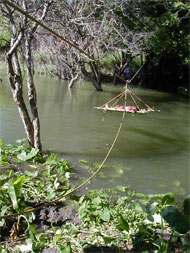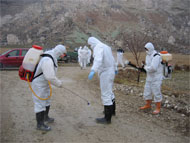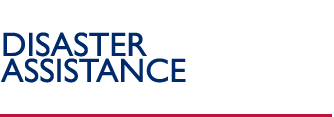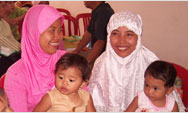 |
USAID's Office of U.S. Foreign Disaster Assistance (OFDA)
Preparedness and Mitigation Programs
"Disaster risk reduction is not a luxury. It's an essential insurance policy for a more disaster-prone world,
and one of the smartest, most cost-effective investments we can make in our common future. The
benefits of this investment will be calculated not only in dollars saved, but most importantly, in saved lives." - Jan Egeland, Former U.N. Under-Secretary General for Humanitarian Affairs and Emergency Relief Coordinator
Each year, USAID provides humanitarian assistance in the wake of natural disasters such as earthquakes, floods, and volcanoes. To minimize the risks of
these and future disasters, USAID funds numerous disaster preparedness and mitigation programs. By making these strategic investments, USAID is saving lives,
alleviating suffering, and reducing the economic impact of disasters by organizing and preparing communities before they are in jeopardy.
Since shortly after its establishment in 1964, OFDA has been a leader among international donors in risk management. OFDA strives to tailor programs to the
specific-and often multiple-hazards that communities face, while building local disaster management capabilities. By empowering individuals at the host government,
community, and local levels to identify, prevent, mitigate, and respond to future crises, USAID continues to work toward advancing self-sufficiency in disaster management.
When countries can effectively manage their own risks, human and economic investments are safeguarded and become part of a country's sustainable development.
Regional Initiatives

|
In a preparedness drill in Honduras, a person stranded by flooding is rescued by community members. |
Latin America and the Caribbean – USAID’s commitment to the development of disaster risk management practices in Latin America and the Caribbean (LAC) is best illustrated through the Regional Disaster Assistance Program (RDAP), a training program established in 1989. Early RDAP initiatives focused on “training of trainers” to transfer knowledge to local instructors and ensure that the program’s impact would be multiplied many times over as host country institutions assumed full responsibility for implementation of the training course.
As of September 2007, 44,339 people, including elected officials, civil service employees, and staff from local relief agencies had participated in RDAP, and 4,686 instructors had been certified in 30 countries. As a result, USAID’s investment has returned huge dividends and reached the breadth of actors working in disaster management throughout the region. Following increased capacity by governments and disaster response organizations, USAID has adapted RDAP from a strictly instrumental approach to providing more technical assistance for planning, strengthening, and centralizing the role of national organizations in disaster management.
South Asia – Since 1998, and with more than $9.5 million in funding, USAID has supported the Program for the Enhancement of Emergency Response (PEER) as part of a preparedness and mitigation strategy for South Asia. The program initially targeted four highly earthquake-prone countries—India, Indonesia, Nepal, and the Philippines—and later expanded to include Bangladesh. In 2006, the program again expanded following the Government of Pakistan’s decision to officially adopt PEER after a powerful magnitude 7.6 earthquake struck near Muzaffarabad on October 8, 2005.
Implemented by the National Society for Earthquake Technology based in Kathmandu, Nepal, the current phase of PEER promotes disaster preparedness through the development of national and regional cadres of professional emergency response instructors. While PEER is geared primarily towards earthquake preparedness, the courses are widely applicable to any disaster involving collapsed structures or mass casualties. The program assists local, national, and regional disaster management agencies in organizing and conducting trainings in medical first response, collapsed structure search and rescue, and hospital preparedness for mass casualties after a disaster. Over the last 7 years, PEER has graduated more than 800 personnel trained as instructors, rescuers, responders, and hospital preparedness professionals.
Africa – USAID preparedness efforts in Africa emphasize building local resilience to disasters and improving communications, transportation, and information networks to more effectively respond to disasters. As part of USAID’s Urban Search and Rescue (USAR) capacity-building program in South Africa, 26 firefighters from across the country received training in structural collapse situations from May 23 to 30, 2006. With support from USAID and Rescue South Africa, six trainers from Fairfax County, Virginia, and Los Angeles County, California, fire departments conducted the “train-the-trainer” program, which focused on rescues in an urban setting following a sudden-onset disaster. These disasters ranged from a building collapse to vehicle crashes into buildings, trench collapses during foundation-setting, and earthquakes. USAID’s program has spurred the creation of a training cadre that will ensure continued operation and expansion of South Africa’s USAR capacity.
Central Asia – In late January and early February 2005, unusually heavy snowfall and frigid temperatures throughout much of Afghanistan led to food insecurity, outbreaks of infectious diseases, and deaths from avalanches and exposure to the cold. Food insecurity increased as most major highways were closed due to heavy snowfall, blocking access to provincial capitals as well as rural areas. Recognizing the need to prepare for expected consecutive harsh winters, USAID provided more than $1.5 million to the U.N. Development Program’s winterization project for the 2005/2006 season. USAID’s contribution included an in-kind donation of 40,000 blankets for internally displaced persons and returnees in Kabul and 11 high-risk provinces.
Middle East – While many hazards are natural in origin, a host of socio-economic trends, such as urbanization and environmental degradation, are forcing the settlement of hazard-prone, marginal lands in rural and urban areas. For instance, the Jordan River Valley, the most seismically active region in the Middle East, has a growing urban population vulnerable to earthquakes. To address these hazards, USAID engaged partners from the Fairfax County Fire and Rescue Department, Virginia Task Force One, to improve the management, operational, and logistical capacity of the Government of Jordan’s Civil Defense. By sharing best practices and training skills, USAID increased the capacity of the Jordanian Civil Defense to provide immediate life-saving assistance to countless beneficiaries in response to sudden-onset urban disasters.
Transnational Preparedness:
In December 2003, the highly pathogenic H5N1 strain of avian influenza emerged in Southeast Asia, first killing migratory birds and domestic poultry and later infecting humans, often with fatal results. Since that time, the virus has steadily spread. With hundreds of millions of birds killed in the effort to contain the disease, the impact on lives and livelihoods has been great. Due to the disease’s virulence, the international community is concerned about the disease spurring a pandemic. To confront this threat, USAID—in close collaboration with the U.S. Department of State, U.S. Department of Health and Human Services, U.S. Department of Agriculture, U.N. World Health Organization, U.N. Food and Agriculture Organization, the World Organization for Animal Health, and foreign governments—has developed a multi-faceted strategy that includes disease surveillance, planning and preparedness, outbreak response, communications, and commodity stockpiles.

|
A team of USG and local health experts attired in personal protective equipment use decontamination spray after investigating an outbreak of avian influenza in Turkey. |
In FY 2006, utilizing years of experience procuring, transporting, and warehousing disaster relief supplies, USAID created and managed the Avian Influenza International Stockpile. The importance of the stockpile cannot be underestimated, as countries battling avian influenza require readily available emergency commodities to respond to outbreaks in animals or humans. While commodities form only one part of a comprehensive material, technical, and financial plan to combat avian influenza, equipment donations have enabled vigorous and timely outbreak management in the field.
USAID developed three standardized response kits based upon best-practice recommendations of U.S. and international technical lead agencies and procured the items with funds appropriated by the U.S. Congress. The stockpile contains essential items used to support the investigation and control of infectious disease outbreaks, including coveralls, gloves, masks, goggles, backpack sprayers, disinfectant powder, soap, scrub brushes, buckets, respirators, surgical scissors, testing materials, and sample storage containers. As of October 2006, the stockpile had 1.5 million sets of personal protective equipment,
100 laboratory kits, and 15,000 decontamination kits for rapid delivery to countries responding to outbreaks. In FY 2006, USAID provided more than 93,000 sets of personal protective equipment for first responders to outbreaks in 66 countries.
Back to Top ^
|


